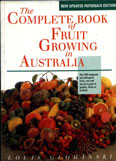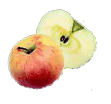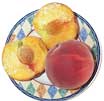December Newsletter 2001
2001 Xmas Party

From left to right: Back; Greg, Geoff, Rodney, Robert, Lincoln, Rick
Front; Donna, Wayne, Emma, Carol, Kimberly
Once again our Christmas party was filled with loads of food, drink and most importantly - Laughter. This year we chose a survivor theme party. You guessed it, the last team member standing and the one to put in a great effort won the grand prize. Wayne did a fantastic job as coordinator and proof of the success of the party was that non-nursery members had a fantastic time and didn't want to go home. If you're interested in any of the other great games we played at our party send me an email and I'll tell you more.
Your chance to win a $50 voucher.
 We'd love to involve you in our Christmas celebrations. Please email me with who you think may have been the survivor of the party and you will go into a drawer to win a $50.00 gift voucher. Thats right, one lucky winner will have $50 to go towards their next plant order or any of the gardening books we sell.
We'd love to involve you in our Christmas celebrations. Please email me with who you think may have been the survivor of the party and you will go into a drawer to win a $50.00 gift voucher. Thats right, one lucky winner will have $50 to go towards their next plant order or any of the gardening books we sell.
A Christmas invitation to our readers
Visit the Nursery - The festive season is a great time to drop into the nursery and say hello. We love to meet our customers and Emma has bundles of great Christmas specials available in the reta il department. To take advantage of this offer be sure to mention that you saw it on our website or in your December newsletter.These are some of the great offers available during December, January and February in our retail section. All you need to do is purchase $200 or more worth of trees and the following gifts are yours -FREE!!!
il department. To take advantage of this offer be sure to mention that you saw it on our website or in your December newsletter.These are some of the great offers available during December, January and February in our retail section. All you need to do is purchase $200 or more worth of trees and the following gifts are yours -FREE!!!
Not only will you receive a discount of 10% on your purchase, but we will also add a xmas gift of
16 Rainforest Trees valued at $32 completely FREE, and
A FREE copy of Louis Glowinksi's brilliant book, 'The Complete Book of Fruit Growing in Australia'. (380 pages of fruitfull information), the best fruit tree reference in Australia. Normal Retail price $49. This gift totals $100 FREE for all orders $200 and over.
NB: This offer does not apply to mail orders or delivery services. Offer applies only upon visitation to the nursery during trading hours. One gift offer per person per day. Valid only until 28 February 2002.
Why not give someone you love a living gift this Christmas?
We have some great gift ideas for gardening enthusiasts and their friends. Some of the most popular Christmas gifts are plants suited to container growing. A dwarf apple, kumquat, Blueberries or Dwarf peach look spectacular in decorated pots and will fruit within a year.
Citrus are well suited to container planting and do very well in an indoor, patio or outdoor situation. They are easy to maintain and grow naturally into an attractive ball shape. The trees have beautiful dark green glossy foliage and are covered with either fruit or delightfully scented flowers most of the year.
Some good varieties to try:
Meyer Lemon
Blooms early, They usually fruit the first year. Hardy to 18F and ornamental, being slightly sweet with an excellent lemon flavour. It has a yellow-orange colour, is juicy and tender. This tree is a lovely container plant and will produce well in a pot.
Meiwa or Nagami Sweet Kumquat
Beautiful bright orange fruit cover a lush, dense small tree. Excellent for container planting. The best fresh eating kumquat! A variegated Kumquat is a lovely citrus variety. The foliage of this tree is variegated green and white.
 Apples are the most popular of all fruits. They are convenient, perfect for eating raw as a nutritious snack or ideal for making into a multitude of hot and cold puddings and deserts. The foliage is a beautiful mint green which makes a stunning contrast against the bright red apples.
Apples are the most popular of all fruits. They are convenient, perfect for eating raw as a nutritious snack or ideal for making into a multitude of hot and cold puddings and deserts. The foliage is a beautiful mint green which makes a stunning contrast against the bright red apples.
The best variety for container growing is the Anna apple.
Dwarf Peaches are stunners when used as container grown plants. They have beautiful dark green spear shaped leaves that have an attractive weeping habit. They commence bearing in as little as a year and produce luscious fruit that has a very attractive pink blush.
The best varieties for container growing are dwarf or standard dwarf trees.
Blueberries
 Christmas Gift Vouchers
Christmas Gift Vouchers
Vouchers are a great idea for your gardening friends that have everything. They are easily ordered online or over the phone and are sent out on beautifully printed paper along with our full descriptive catalogue. Vouchers are available for any amount over $20.
SPECIAL OFFER - During the months of December and January we are offering $100 vouchers for the discounted rate of only $85.00.
Frequently asked questions
In this newsletter as of all those previous we try our best to answer many of the recurring questions that create a bit of confusion for gardeners throughout the year. One topic of importance is that of Soil pH and quality potting mix. Both are crucial to a plants health. Here are some of the reasons why.
Soil pH - Why its so important
Soil pH measures how many hydrogen ions are affecting plant roots. The more hydrogen ions present in the soil, the more acidic the pH. The pH scale ranges from 1 (extremely acid) to 14 (extremely alkaline). At pH 7 (neutral), hydrogen ions have little effect on the plant's root ability to absorb nutrients. Scientists have found that plants generally need a small amount of acidity in the soil for optimum growth. The roots seek out the major soil nutrients: nitrogen, phosphorus, and potassium absorbing them for healthy flower, leaf and root development.
The ideal soil pH for many plants is a range of pH 5.5 to 6.5. In this range most nutrients are readily available. Extremes of low and high pH levels are detrimental to plants as they become toxic or lock up nutrients making them unavailable to plants.
In general, areas with heavy rainfall tend to have more acidic soil while drier parts of are usually too alkaline. To increase acidity, you can use garden sulfur but be sure not to apply it during very hot weather. Dolomite is recommended for gardens that are low in magnesium. Work the lime or sulfur into the soil at most times. The soil will slowly revert to its original pH so it's a good idea to re-test it every two years by using a simple test kit or taking a sample to a specialist.
Potting Mix - What's a good MixThere are two Australian Standard potting mix grades: Regular and Premium.
Both mixes must be freely draining, while capable of holding a good supply of water. Both must be easy to rewet if they dry out. They must be free of toxins and have a pH in the range 5.3 - 6.5. Both mixes should contain a full range of trace elements in sufficient quantities to last for at least one year of plant growth, as well as ample initial amounts of phosphorus, calcium, magnesium and sulphur.Regular mixes are not required to contain any soluble nitrogen, however, the worst of their ability to 'draw down' fertiliser nitrogen will have been removed.
Premium mixes must contain soluble nitrogen and be able to continue providing enough soluble nitrogen for at least one month of good plant growth. Premium mixes generally contain slow release fertiliser and will have been made from high quality materials such as thoroughly composted pine bark and peat.
A premium mix may appear to be initially more expensive than other mixes, however, their reliability and quality make them less expensive in the long run.
White Sapotes
 We sell various types of Sapotes. The Black Sapote, White Sapote and the Green, Yellow and Mamey Sapotes. These three groups all have one thing in common, they are deliciously sweet hence the name sapote meaning 'Sweet', but that is where the close similarity ends. All three groups come from different families. The Black Sapote is a close relative of the Persimmon and is from the Ebanaceae family, The Green, Yellow and Mamey Sapotes are the most tropical of the group and are members of the Sapotaceae family and last but certainly not least is the White Sapote or Casimiroa that along with Citrus and Wampee has its place in the Rutaceae family.The fruit is one of those forgotten delicacies that has extraordinary potential. The creamy textured flesh is sweet and rich and often compared to banana custard. The best way to eat the fruit is to cut it in half, remove the seed and spoon out the butter like flesh. If you find yourself with an abundance of fruit, mash the pulp and freeze it. The pulp freezes well for up to 12 months and retains its flavour when thawed. Its also delicious used in milkshakes, icecream and many desserts.The tree is a long-lived evergreen that is large and spreading. The foliage is a deep glossy green with compound leaves of five fingers. Grafted trees reach 7 to 10 metres in height. It is a strong tree that can withstand windy conditions and the weight of its abundant fruit. It is respected as one of the heaviest bearing of all fruit trees and is relatively problem free.For best results we recommend planting two varieties, Lemon Gold or Ortago being one of the two. Visit our catalogue for more information on the Reinecke Commercial, Pike and Chris.
We sell various types of Sapotes. The Black Sapote, White Sapote and the Green, Yellow and Mamey Sapotes. These three groups all have one thing in common, they are deliciously sweet hence the name sapote meaning 'Sweet', but that is where the close similarity ends. All three groups come from different families. The Black Sapote is a close relative of the Persimmon and is from the Ebanaceae family, The Green, Yellow and Mamey Sapotes are the most tropical of the group and are members of the Sapotaceae family and last but certainly not least is the White Sapote or Casimiroa that along with Citrus and Wampee has its place in the Rutaceae family.The fruit is one of those forgotten delicacies that has extraordinary potential. The creamy textured flesh is sweet and rich and often compared to banana custard. The best way to eat the fruit is to cut it in half, remove the seed and spoon out the butter like flesh. If you find yourself with an abundance of fruit, mash the pulp and freeze it. The pulp freezes well for up to 12 months and retains its flavour when thawed. Its also delicious used in milkshakes, icecream and many desserts.The tree is a long-lived evergreen that is large and spreading. The foliage is a deep glossy green with compound leaves of five fingers. Grafted trees reach 7 to 10 metres in height. It is a strong tree that can withstand windy conditions and the weight of its abundant fruit. It is respected as one of the heaviest bearing of all fruit trees and is relatively problem free.For best results we recommend planting two varieties, Lemon Gold or Ortago being one of the two. Visit our catalogue for more information on the Reinecke Commercial, Pike and Chris.
Tropical Peaches
With all of the delicious exotics available in this subtropical climate its good to see that the tropical Peach stills holds its own for taste and versatility. All the peach varieties we have listed are chosen due to their disease resistance, appearance and most importantly their  taste. Two of
taste. Two of  the best performers are the
the best performers are the
Tropic Beauty and the Tropic Snow peach. As the name Tropic Snow suggests this peach has a white flesh, the Beauty having a yellow flesh. Both Peaches bear at around the same time (October - November) but the beauty only requires 150 hours chill compared to the Snows 250 hours.Both have exceptional tasting firm flesh with the Snow being judged slightly ahead of the Beauty.Consumers aren't as used to the white fleshed varieties and they don't have as high a percentage of blush but when you weigh up their superb taste along with their disease resistance and non-browning flesh, they are definately deserving of a place in the most prized home orchard.
Christmas Cheer from Greg and the crew
Thank you very much for all your support during 2001. We look forward to being of service in the New Year and wish you many gardening experiences and surprises. Greg
To post your message please Contact Us





